SWISS – Secondment Works In Scenic Switzerland

Within the Marie Skłodowska-Curie Action (MSCA) research fellowship framework, secondments form a crucial part of each Early Stage Researcher’s (ESR) development. Indeed, the secondments promote the values of European collaboration, and permit the building of stronger professional networks across diverse and fluctuating work milieux. In this post here, we will take a peek into the ITN-CHANGE secondments that took place in the spring of 2021 and gave rise to fruitful collaborations between Agnese Babini (ESR1), Jan Cutajar (ESR10), and Silvia Russo (ESR11) in Switzerland. These secondments were driven by the requirement to make avail of specialised scientific equipment, or to access museum collections, that were not available at their host institutions.
Jan and Agnese were each supposed to travel from Norway to Swiss ITN-CHANGE beneficiaries (namely, Haute Ecole Spécialisée de Suisse Occidentale (HES-SO) in Neuchâtel, and the Swiss National Museum (SNM) in Zürich, respectively) at separate times during their projects; similarly, Silvia was also meant to reach Norway (at the Norwegian University of Science and Technology (NTNU) Gjøvik) from Switzerland for her own secondment. The COVID-19 pandemic, however, impacted all of their plans and timelines, such that serendipitously all three of them were in Switzerland at the same time, together with another two Swiss-based ESRs (Deepshikha Sharma (ESR12) and Amalia Siatou (ESR15)). Although these delays seemed discouraging at first, in hindsight it can be said that the mere coincidence of finding each other in the same place and the same time by chance led to collaborations which a priori had not even been conceptualised.
In the following sections, we will share a few of their experiences together, which have led to advances in each of their own projects, as well as to more leisurely moments of discovery in the mountain-laden valleys of Switzerland.
Haute école spécialisée de Suisse occidentale HE-Arc CR
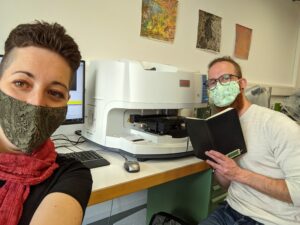
During a period of three months starting in April 2021, Haute Ecole Arc Conservation restauration (HE-Arc CR) of HES-SO served as an ideal meeting ground for fertile collaboration between Jan and Silvia.
One of Jan’s main objectives was to carry out micro-Fourier transform infrared spectroscopy (µFTIR) analyses for the characterisation of artificial soiling on mock-ups of two monumental oil painting masterpieces by Edvard Munch, Chemistry (Woll no. 1227) and The Source (Woll no. 1226) preserved in the University of Oslo (UiO) Aula in the centre of Norway’s capital.

Jan and Silvia’s common interest in spectroscopy (given their shared background in chemistry), and in understanding the mechanisms of degradation of oil paints, provided the appropriate platform for their collaboration. The two researchers devoted numerous hours to finding the right parameters for the acquisition of chemical maps, that would be informative of the contamination layers deposited on the surface of the painted samples. The success of these campaigns has meant that the processing of this data is currently ongoing, given the vast amount of information gathered. It is hoped that the joint effort between the two ESRs during this phase of the work will shortly bear its fruit, and possibly result in a scientific communication.
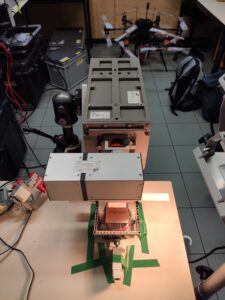
Another research axis, common to many ITN-CHANGE ESRs, and particularly to Jan and Silvia’s projects, is the use of hyperspectral imaging (HSI) cameras to monitor physical and chemical change, of which degradation. During Jan’s stay in Switzerland, the two fellows were granted the possibility to test two hyperspectral cameras belonging to the Centre d’hydrogéologie et de géothermie (CHYN) of the University of Neuchâtel (UniNe) and the Engineering department at HE-Arc (see pictures to the left and below). The cameras operated in the short-wave infrared (SWIR) ranges of the electromagnetic spectrum and in the visible-near infrared (VNIR). Linseed oil-coated metal model samples from Silvia’s project were chosen for assessing the potential of such a technique in complementing the information obtained through more traditional analytical methods (such as the previously mentioned µFTIR).
Silvia’s familiarity with the formation of metal soaps on painted metals, together with Jan’s growing expertise in hyperspectral imaging techniques for the monitoring of cultural heritage objects were vital for the pursuit of such research tasks. These skillsets were acquired throughout the two years of formation and training on the job they underwent as part of the ITN-CHANGE fellowship.

Photo (left): Set-up of the VNIR hyperspectral camera on an oil-painted metal shop sign «Lido 1870 » (ML/2019/0830, Musée du Léman à Nyon, Switzerland).

Photo (right): Complementary infrared image taken using a FLIR camera, which was used to monitor the temperature of the painted surface.
Swiss National Museum
Agnese arrived in Switzerland in May 2021 for a one-month stay, carrying precious scientific equipment from NTNU, namely a VNIR-HSI camera. Her work involved the scanning of some case study objects (including 811 singular coloured glass pieces!) using hyperspectral imaging, which were stored at the Collection Centre of the Swiss National Museum outside Zürich. The set-up for the acquisition was built in the underground storerooms of the Collection Centre (since dark conditions were a prerequisite for the scans) with a combined effort from Agnese, Deepshikha (who is based there as an ESR) and Jan (who joined for a short visit from Neuchâtel). Although the work conditions were challenging and dictated by time restraints, the collective adaptability and creativity of the staff at the SNM and the ESRs allowed for a successful data collection campaign (see photos below).
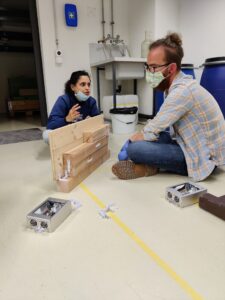
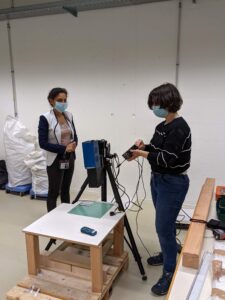

Photos: Jan, Deepshikha and Agnese working at the SNM Collection Centre, here shown adapting the HSI set-up according to need.
Before packing and shipping everything back to Norway, Agnese also managed to squeeze some time to help Silvia with her own metal coupons. The coupons were scanned with the VNIR-HSI camera from Gjøvik (that acquires within a broader spectral range than the one in Neuchâtel), to investigate whether metal soap degradation could be captured, identified and documented using this technique. This collaboration eventually fed into the work Jan and Silvia has carried out previously at HE-Arc, and so a seamless chain of cooperation was created between the three.
Touring around Switzerland and beyond..
Although this was a period of intense activity and hard work – into which much planning had been poured, and then much adapting was inevitably required – the ESRs also found the time to let their hair down and discover the charm of their host country, Switzerland. Neuchâtel and Zürich respectively both offered many cultural gems in terms of urban cityscapes, as well as surrounding natural beauty. The ESRs took the opportunity to visit each other in these cities on the weekends, but also ventured out to other places of note such as Basel and Bern, as well as the famed, domineering Alps in the Valais and Vaud cantons. Given that Switzerland is at the crossroads of central Europe, Agnese also took the opportunity to visit the ITN-CHANGE team in Dijon, and another colleague in research in Mulhouse.



Photos above and below: The CHANGE-ITN ESRs in different moments in Neuchâtel, Zürich (Switzerland) and Dijon (France).
From the get-go, these outdoor ramblings and historic city explorations permitted the ESRs to strengthen the bonds between themselves, whilst learning about social contexts and natural landscapes that otherwise might have escaped their notice. Furthermore, apart from deepening already cherished connections, the spring secondments allowed opportunities for further networking, both from a professional point of view with hosting supervisors and their fellows, as well as from a collegiate standpoint with other PhDs and researchers at the visited ITN-CHANGE institutions.
Now that each ESR is back at their host institution and the dust is settling (as a CHANGE saying goes: “the dust is always settling on the Munch paintings!”), it is clear to Silvia, Jan and Agnese that this experience was one well-worth pursuing, both in terms of the data and results amassed, as well as from the viewpoint of growth as researchers, and persons. The learning opportunities have allowed them all to deepen their expertise further in their fields, grasp new concepts in the spirit of collaboration, and thus build networks which will serve as building blocks for future work. In concrete terms, this also means that each ESR is processing all the new information gathered, and resultantly pursuing new avenues of research which they hope will soon result in publications, so do keep an eye out for that!
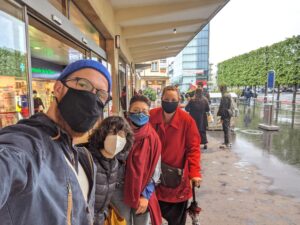

The ESRs would also like to take this opportunity to gratefully thank their secondment hosts and supervisory teams for all their generous support whilst hosting them, helping in the administrative organisation of the trips, and providing access to the equipment and collections described in this article.


